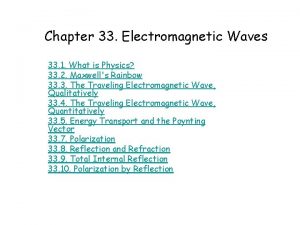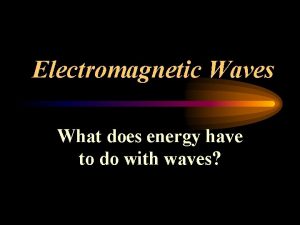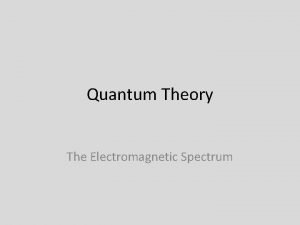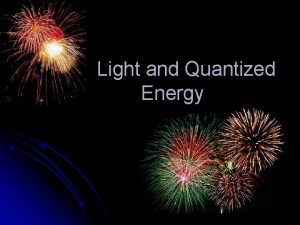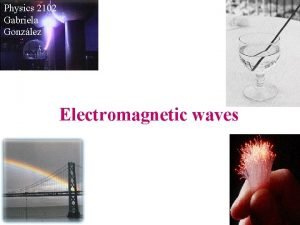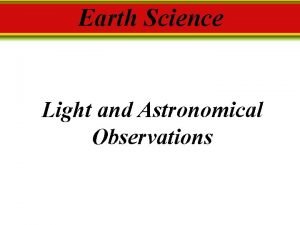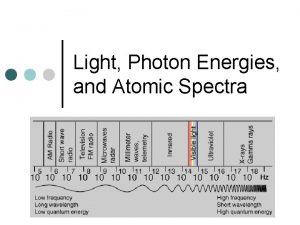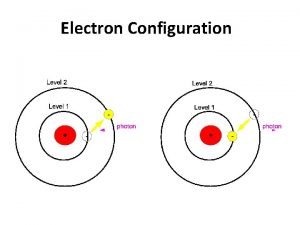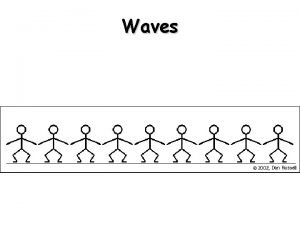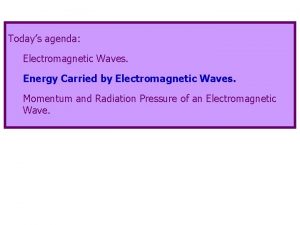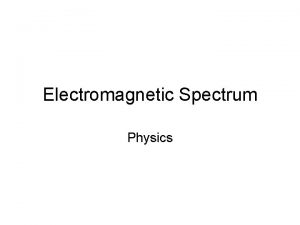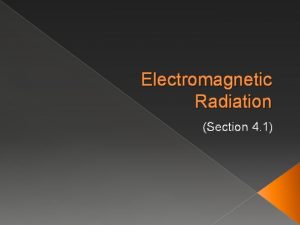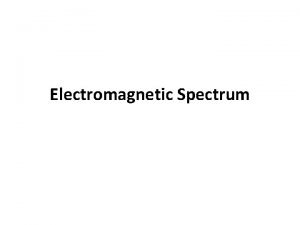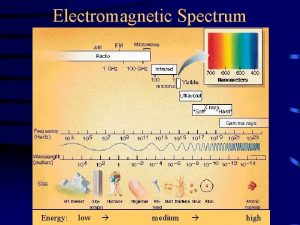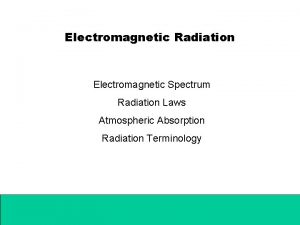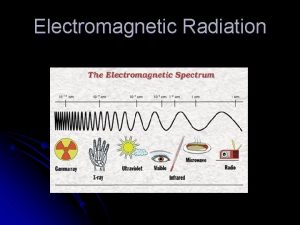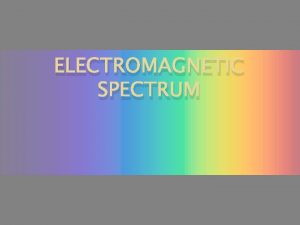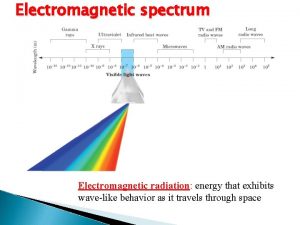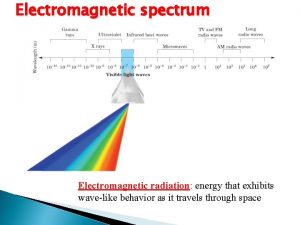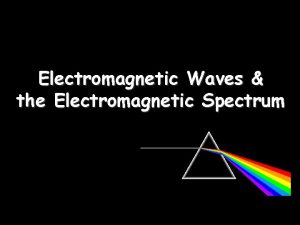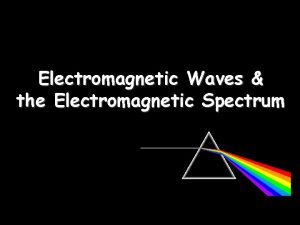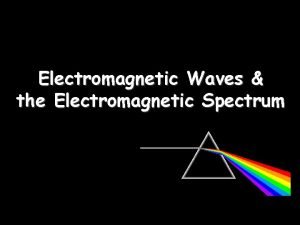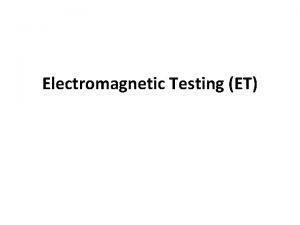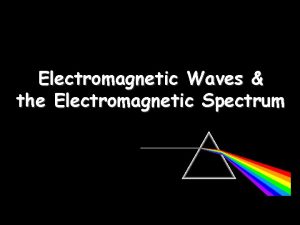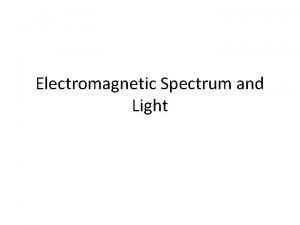I Electromagnetic Radiation high energy radiation that does





















- Slides: 21

I. Electromagnetic Radiation- high energy radiation that does not need a medium through which to travel

A. Range: (wavelength) 3 x 10 -15 to 3 x 108 cm B. Type of Wave: transverse wave

C. Definition of light: that portion of the electromagnetic spectrum that we can sense with our eyes

D. Speed of Light: 186, 000 miles /sec or 300, 000 km/sec 1. Octagonal Mirror Method: Measured speed of light across mountaintops: Mt. Wilson to Mt. San Antonio

II. Sources of Light A. Luminous Objects 1. Defined: objects that produce their own light energy 2. Examples: sun, light bulb, fire, piezoelectric effect

B. Illuminated Objects 1. Defined: objects that reflect light energy 2. Examples: moon, planets, mirror, matter

III. Photometry – science of light measurement A. Intensity of Light: amplitude (brightness) 1. Units: candela 2. Method of Measurement: by comparison (grease spot photometer)

B. Luminous Flux – amount of light energy that reaches a surface 1. Units: lumen 2. Equation: F = 4 p. I I = intensity in candela

C. Illuminance (illumination): light energy/unit surface area 1. Units: lumens/m 2 2. Equation: E = F/S. A. = 4 p. I/4 pr 2 = I/ r 2

IV. Light and Matter A. Reaction to Light 1. transparent: allows light to pass uninterrupted 2. translucent: allows light to pass but diffuses it 3. opaque: allows no light to pass

V. Color A. Light 1. Primary Colors a. red, blue, green 2. Secondary Colors a. yellow, cyan, magenta

B. Dyes and Pigments 1. Primary pigments a. yellow, cyan, magenta 2. Secondary pigments a. red, blue, green

VI. Law of Reflection A. Angle of incidence = angle of reflection B. Objects in a Plane Mirror 1. virtual and upright

C. Concave Mirrors 1. Graphical location • principal axis- axis through the center of curvature but perpendicular to the chord of the mirror • focal point – point of convergence for parallel rays of light that reflect from the mirror

c. center of curvature – radius of the mirror (located at two times the focal length) d. object distance – distance from the mirror to the object e. image distance – distance from the mirror to the image

2. Mirror Equation a. 1/f = 1/do + 1/d 3. Magnification hi/ho = di/do i

D. Convex Mirrors 1. Type of image- always virtual, diminished, and upright

VII. Refraction A. Defined: the bending of light as it enters obliquely from one medium into another B. Snell’s Law: n 1 sinq 1 = n 2 sinq 2

C. Convex Lenses 1. Graphical location a. principal axis – axis that lies through the optical center and focal point of the lens b. focal point - point of convergence for parallel rays of light that strike the lens c. focal length x 2 – point used to locate the image d. object distance - distance from the lens to the object e. image distance - distance from the lens to the image

D. Concave Lenses – produces only a virtual, erect image

E. Equations for lenses 1/f = 1/do + 1/di Magnification hi/ho = di/do
 Phân độ lown ngoại tâm thu
Phân độ lown ngoại tâm thu Block xoang nhĩ độ 2 type 1
Block xoang nhĩ độ 2 type 1 Thể thơ truyền thống
Thể thơ truyền thống Thơ thất ngôn tứ tuyệt đường luật
Thơ thất ngôn tứ tuyệt đường luật Chiến lược kinh doanh quốc tế của walmart
Chiến lược kinh doanh quốc tế của walmart Tìm độ lớn thật của tam giác abc
Tìm độ lớn thật của tam giác abc Hãy nói thật ít để làm được nhiều
Hãy nói thật ít để làm được nhiều Tôn thất thuyết là ai
Tôn thất thuyết là ai Gây tê cơ vuông thắt lưng
Gây tê cơ vuông thắt lưng Sau thất bại ở hồ điển triệt
Sau thất bại ở hồ điển triệt Intensity in em wave
Intensity in em wave Facts about electromagnetic radiation
Facts about electromagnetic radiation Wavelength formula electromagnetic wave
Wavelength formula electromagnetic wave Types of radiation in the electromagnetic spectrum
Types of radiation in the electromagnetic spectrum Intensity of electromagnetic radiation
Intensity of electromagnetic radiation Which telescope detects invisible electromagnetic radiation
Which telescope detects invisible electromagnetic radiation Longitudinal vs transverse wave
Longitudinal vs transverse wave Electromagnetic spectra
Electromagnetic spectra When electromagnetic radiation of wavelength 300
When electromagnetic radiation of wavelength 300 Em wave spectrum
Em wave spectrum Electromagnetic energy def
Electromagnetic energy def Energy density em wave
Energy density em wave










